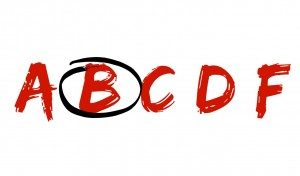When Grading Harms Student Learning
CompetencyWorks Blog
 This post originally appeared at Edutopia on November 23, 2015.
This post originally appeared at Edutopia on November 23, 2015.
There are so many forces at work that make educators grade, and grade frequently. For sports eligibility, coaches constantly look at grades to see if a student is at an academic level that will allow him or her to play. Colleges review transcripts to examine what type of courses students took and their corresponding grades. Teachers must follow policy that demands them to enter a certain amount of grades every week, month, or marking period. There’s no stopping it. However, we need to reflect upon policies and practices like this – and possibly consider regulating them. Is grading the focus, or is learning the focus? Yes, grades should and can reflect student learning, but often they can get in the way and actually harm student learning.
The Dreaded Zero
I used to give out zeros in the hopes that it would force students to do work and learn. This was a terrible idea! I’m so happy that I received the professional development and resources to challenge my thinking on how I was graded as a student. Myron Dueck notes that students need to care about consequences, and many students simply don’t care about zeros. In fact, some of them will say, “Fine, I’ll take the zero,” which totally defeats the intended purpose and in fact destroys any leverage that I have to help students learn. Zeros do not reflect student learning. They reflect compliance. Instead of zeros, we should enter incompletes, and use these moments to correct behavioral errors and mistakes. Often, one zero can mathematically destroy a student’s grade and pollute an overall metric that should reflect student learning. Here, grading is getting in the way of truly helping a student, as well as showing what that student really knows.
Points Off for Late Work
I’m guilty of this one as well. Similar to using zeros, when students didn’t turn in work on time, I threated them with a deduction in points. Not only didn’t this correct the behavior, but it also meant that behavioral issues were clouding the overall grade report. Instead of reflecting that students had learned, the grade served as an inaccurate reflection of the learning goal. Well, I certainly learned from this experience, and instead began using late work as a time to actually address the behavioral issue of turning in late work. It was a teachable moment. I had students reflect on what got in the way, apply their problem-solving skills to these issues, and set new goals. Students should learn the responsibility of turning in work on time, but not at the cost of a grade that doesn’t actually represent learning.
Grading “Practice”
Many of our assignments are “practice,” assigned for students to build fluency and practice a content or skill. Students are often “coming to know” rather than truly knowing. Consequently, these assignments are formative assessments, reflecting a step in the learning process and not a final outcome or goal. Formative assessment should inform instruction. It should not be graded. If we assign a grade to failed practice, the overall grade won’t reflect what they learned. It won’t be a reflection of success, and it may even deter students from trying again and learning. Practice assignments and homework can be assessed, but they shouldn’t be graded.
Grading Instead of Teaching
As mentioned earlier, many teachers are required to enter grades on a frequent basis. While this policy may be well intended, in practice it can become a nightmare and run afoul to the intent. Districts and schools often call for frequent grades so that students, parents, and other stakeholders know what a child knows, and what he or she needs to learn next. This is a great intent. In fact, we should formatively assess our students and give everyone access to the “photo album” of learning rather than a single “snapshot.” However, if we educators do nothing but grade, we rob ourselves of the time that we need to teach. We’ve all been in a situation where grading piles up, and so we put the class on a task to make time for grading. This is wrong, and it should be the other way around. Teaching and learning should take precedence over grading and entering grades into grade books. If educators are spending an inordinate amount of time grading rather than teaching and assessing students, then something needs to change.
Hope
Our work as educators is providing hope to our students. If I use zeros, points off for late work, and the like as tools for compliance, I don’t create hope. Instead, I create fear of failure and anxiety in learning. If we truly want our classrooms to be places for hope, then our grading practices must align with that mission. Luckily, standards-based grading, mastery-based grading, and competency-based learning are making strides in many schools, districts, and states. These methods more accurately align with the premise that “it’s never too late to learn.” If you want to learn more about equitable grading practices, read work by Ken O’Connor, Myron Dueck, Dylan Wiliam, and Rick Wormeli.
With that, I will leave you with an essential question to ponder: How can we grade and assess in a way that provides hope to all students?
See also:
- Avoiding Learned Helplessness
- Progress and Proficiency: Redesigning Grading for Competency Education
- Getting Up to Speed on Grading
Andrew K. Miller (@betamiller on Twitter) is on the National Faculty for the Buck Institute for Education, an organization specializing in 21st century project-based learning, as well as for ASCD, providing expertise in a variety of professional development needs. He is also a regular blogger for Edutopia.